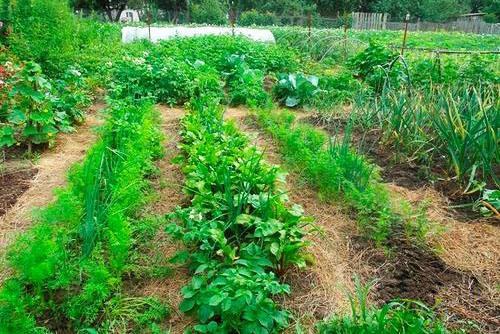Mulch - a "blanket" for the garden
 In early spring, as soon as the snow melts, the wind carries away with it every day up to 60 tons of moisture from each hectare of the plot area. If in the fall you dug up a vegetable garden, then in the spring the weathering of the soil increases significantly. To reduce moisture loss, it is necessary to loosen the surface layer with a rake.
In early spring, as soon as the snow melts, the wind carries away with it every day up to 60 tons of moisture from each hectare of the plot area. If in the fall you dug up a vegetable garden, then in the spring the weathering of the soil increases significantly. To reduce moisture loss, it is necessary to loosen the surface layer with a rake.
The supply of spring moisture is critical to the harvest. Its lack is not compensated by watering and spring rains.
Problems with soil drying can be avoided by sowing green manures in the garden in the fall. They perfectly trap snow in winter and retain moisture in spring.
It is best to cover the garden with a "blanket" - mulch.
What is mulch
Mulch is all you can use to cover the soil. For example, green manure, cut grass, pine needles, fallen leaves, sawdust, all kinds of cake and so on. You can also use newspapers, cardboard, black agrofibre.
Mulching the soil has several advantages:
- moisture retention;
- weed suppression;
- preventing the spread of fungal diseases;
- nutrition of microorganisms;
- organic soil enrichment.
All other things being equal, mulched plants develop much better than those that are not covered by anything.
Why mulch is needed
Let's take a closer look at the benefits of mulching plants.
Moisture retention
When the soil is covered with such a "blanket", evaporation and weathering is difficult. Thanks to the mulch layer, water vapor condenses from the air, and dew falls out. After rain or watering, the soil under the mulch remains wet for a very long time.
You can close the drip tape with mulch and it will work much more efficiently.
Weed suppression
It is necessary to monitor the germination of weeds, periodically weed it and constantly add mulch, since over time the thickness of its layer decreases, and it is easier for weeds to break through it.
The mulch layer should be more than 10 cm.
Preventing the spread of disease
The mulching layer becomes an obstacle to diseases, preventing phytophthora, mildew, mildew, oidium and other fungi from spreading. Hay sticks and Trichoderma quickly grow under the mulch. The causative agents of common fungal diseases are not at all "friendly" with them.
Microorganism nutrition
Under the mulch, the biological activity of the soil increases rapidly. Organic mulch residues are excellent food for all kinds of soil inhabitants, from fungi and bacteria to earthworms. They turn mulch into humus... Plants are well nourished and thrive very well.
Organic soil enrichment
Organic mulch compensates for the removal of nutrients, micro and macro elements from the soil with the harvest. It is rich in carbon compounds, which is a “building material” for plants. Fertility is increasing every year with a simultaneous increase in yield.
Add EM bokashi or preparations with beneficial microorganisms under the mulch. This will start the dynamic fertility process.
Mulch tomatoes, peppers, cabbage, carrot, onions, all shrubs and tree trunks. Potatoes grow great under straw. Strawberry in English strawberry, which means "straw berry".
Video on the use of mulch in the garden